 English
English



-
 Afrikaans
Afrikaans -
 Albanian
Albanian -
 Amharic
Amharic -
 Arabic
Arabic -
 Armenian
Armenian -
 Azerbaijani
Azerbaijani -
 Basque
Basque -
 Belarusian
Belarusian -
 Bengali
Bengali -
 Bosnian
Bosnian -
 Bulgarian
Bulgarian -
 Catalan
Catalan -
 Cebuano
Cebuano -
 China
China -
 China (Taiwan)
China (Taiwan) -
 Corsican
Corsican -
 Croatian
Croatian -
 Czech
Czech -
 Danish
Danish -
 Dutch
Dutch -
 English
English -
 Esperanto
Esperanto -
 Estonian
Estonian -
 Finnish
Finnish -
 French
French -
 Frisian
Frisian -
 Galician
Galician -
 Georgian
Georgian -
 German
German -
 Greek
Greek -
 Gujarati
Gujarati -
 Haitian Creole
Haitian Creole -
 hausa
hausa -
 hawaiian
hawaiian -
 Hebrew
Hebrew -
 Hindi
Hindi -
 Miao
Miao -
 Hungarian
Hungarian -
 Icelandic
Icelandic -
 igbo
igbo -
 Indonesian
Indonesian -
 irish
irish -
 Italian
Italian -
 Japanese
Japanese -
 Javanese
Javanese -
 Kannada
Kannada -
 kazakh
kazakh -
 Khmer
Khmer -
 Rwandese
Rwandese -
 Korean
Korean -
 Kurdish
Kurdish -
 Kyrgyz
Kyrgyz -
 Lao
Lao -
 Latin
Latin -
 Latvian
Latvian -
 Lithuanian
Lithuanian -
 Luxembourgish
Luxembourgish -
 Macedonian
Macedonian -
 Malgashi
Malgashi -
 Malay
Malay -
 Malayalam
Malayalam -
 Maltese
Maltese -
 Maori
Maori -
 Marathi
Marathi -
 Mongolian
Mongolian -
 Myanmar
Myanmar -
 Nepali
Nepali -
 Norwegian
Norwegian -
 Norwegian
Norwegian -
 Occitan
Occitan -
 Pashto
Pashto -
 Persian
Persian -
 Polish
Polish -
 Portuguese
Portuguese -
 Punjabi
Punjabi -
 Romanian
Romanian -
 Russian
Russian -
 Samoan
Samoan -
 Scottish Gaelic
Scottish Gaelic -
 Serbian
Serbian -
 Sesotho
Sesotho -
 Shona
Shona -
 Sindhi
Sindhi -
 Sinhala
Sinhala -
 Slovak
Slovak -
 Slovenian
Slovenian -
 Somali
Somali -
 Spanish
Spanish -
 Sundanese
Sundanese -
 Swahili
Swahili -
 Swedish
Swedish -
 Tagalog
Tagalog -
 Tajik
Tajik -
 Tamil
Tamil -
 Tatar
Tatar -
 Telugu
Telugu -
 Thai
Thai -
 Turkish
Turkish -
 Turkmen
Turkmen -
 Ukrainian
Ukrainian -
 Urdu
Urdu -
 Uighur
Uighur -
 Uzbek
Uzbek -
 Vietnamese
Vietnamese -
 Welsh
Welsh -
 Bantu
Bantu -
 Yiddish
Yiddish -
 Yoruba
Yoruba -
 Zulu
Zulu
vacuum test on transformer tank
Vacuum Test on Transformer Tank Ensuring Reliability and Performance
Transformers are essential components in electrical power systems, serving as key apparatus for voltage transformation and distribution. Their reliability is paramount to the stability of electrical networks. One of the critical factors that influence transformer performance is the integrity of its tank. The vacuum test is a widely used method to ensure that transformer tanks are free from leaks and meet the necessary standards for operation.
A transformer tank is designed to contain the insulating oil that cools and insulates the transformer windings. Over time, factors such as thermal cycling, mechanical stress, and environmental conditions can lead to wear and tear, making it crucial to maintain the tank's integrity. The vacuum test assesses the tank’s ability to hold vacuum pressure, which is a good indicator of its structural soundness.
The Vacuum Test Process
The vacuum test involves several steps, typically executed in a controlled environment. Initially, the transformer tank is subject to a thorough visual inspection. Any signs of corrosion, dents, or previous repairs are documented. Subsequent to this inspection, the tank is evacuated using industrial vacuum pumps to create a negative pressure inside. This process eliminates air and moisture, which can be harmful to the insulating oil.
Once a suitable vacuum level is achieved, the tank is held in this state for a specified duration, usually several hours. During this time, monitoring equipment measures the pressure levels to identify any changes. A drop in pressure could indicate a potential leak or weakness in the tank.
Importance of the Vacuum Test
vacuum test on transformer tank

1. Leak Detection The primary purpose of the vacuum test is to identify any leaks in the transformer tank. Even minor leaks can lead to significant issues, including the ingress of moisture, which can degrade the quality of insulating oil and lead to transformer failure.
2. Assessment of Tank Condition The test provides a comprehensive assessment of the tank’s structural integrity. A successful vacuum test indicates that the tank is strong enough to withstand operational pressures and conditions, providing peace of mind to operators and engineers.
3. Preventive Maintenance By conducting regular vacuum tests, utility companies can schedule maintenance and repairs proactively. This preventive approach helps to avoid unexpected outages and costly repairs, ultimately enhancing the reliability of power supply systems.
4. Compliance with Standards Many regulatory bodies and industry standards mandate rigorous testing of electrical equipment. The vacuum test is often part of the certification process, ensuring compliance with safety and performance standards.
Conclusion
Ensuring that transformer tanks maintain their integrity is essential for the overall reliability and efficiency of electrical power systems. The vacuum test is a critical procedure that not only assists in detecting leaks but also provides valuable insights into the condition of the tank. By employing this testing method as part of a comprehensive maintenance strategy, utilities can enhance the longevity of transformers and ensure uninterrupted service for their customers.
As electrical power systems continue to evolve and expand, the importance of thorough testing methods like the vacuum test cannot be overstated. It plays a vital role in safeguarding equipment and ensuring a stable power supply, ultimately supporting the growing demands of the modern world. By prioritizing maintenance practices such as the vacuum test, operators can lead the way in building resilient electrical infrastructures that will serve future generations.
-
Ensuring SF₆ Gas Safety: Introducing PUSH’s Integrated SF₆ Analyzer for Dew Point, Purity, and Decomposition MonitoringNewsJul.10,2025
-
Exploring the Main Types of Industrial Endoscopes and Their Applications Across IndustriesNewsJul.04,2025
-
Testing Equipment Industry Sees Major Advancements in 2025: Smart & Precision Technologies Lead the WayNewsJun.06,2025
-
Applications of Direct Current Generators in Renewable Energy SystemsNewsJun.05,2025
-
Hipot Tester Calibration and Accuracy GuidelinesNewsJun.05,2025
-
Digital Circuit Breaker Analyzer Features and BenefitsNewsJun.05,2025



